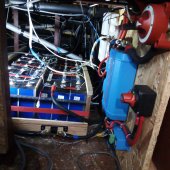Probably not the right thread, but I didnt go with springs in the end. Because I have an arrangement with 3 parallel cells x 8S , I wanted to use fixed busbars across the 3 cells. I used 5mm neoprene between all cells. 1 bar (14psi) compresses almost exactly 1/2 the neoprene. So my 4 rows of 6 cells have 7 layers of 5 mm neoprene. I compress till the 35mm of neoprene is compressed to 1/2 (17mm total over the pack). Any swelling of cells will compress the neoprene but keep the cells in same relative position so no pressure on terminals, so I can use fixed busbars. I suspect longer term pressure on the neoprene will loosen as they permanently compress, but I can check torque on nuts too and adjust if needed. 





